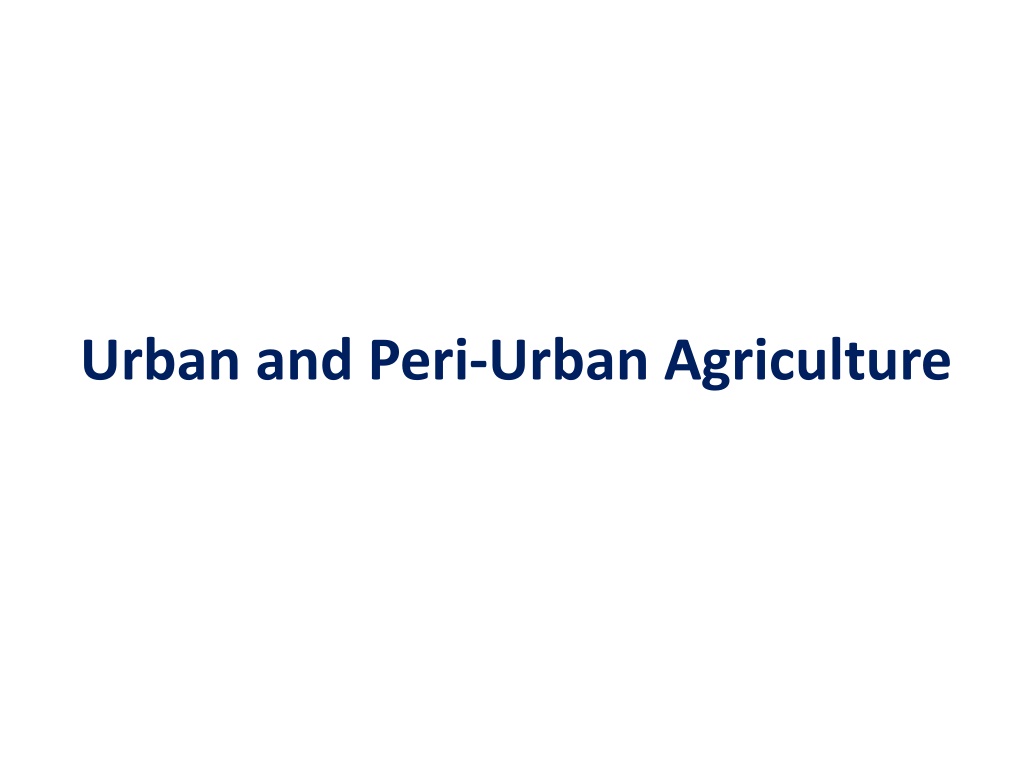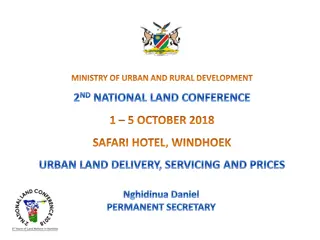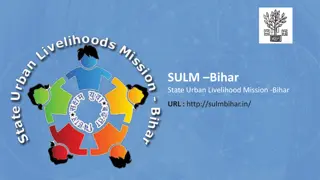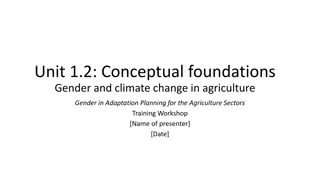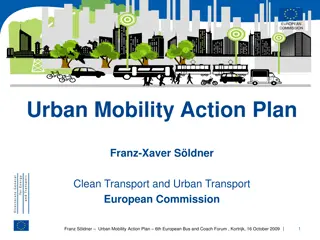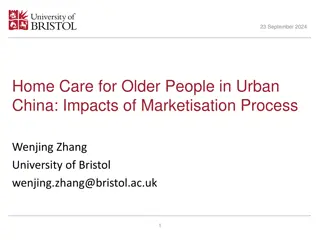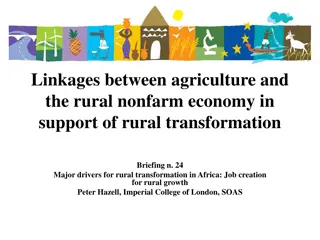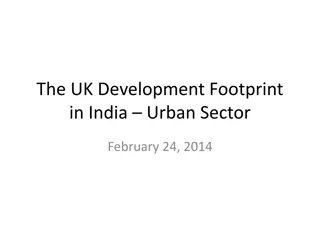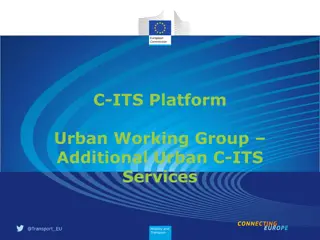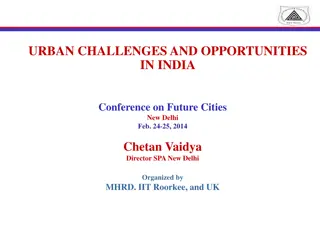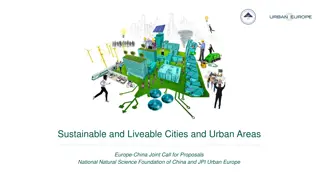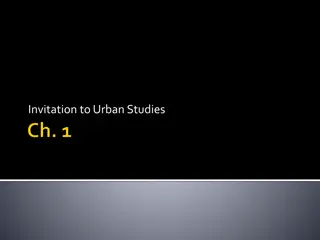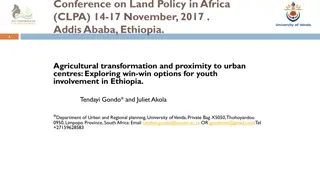Urban and Peri-Urban Agriculture
Urban and peri-urban agriculture involve cultivating, processing, and distributing food in and around cities. This practice integrates various farming technologies, promotes local food production, and offers benefits such as job creation, fresh produce availability, and waste recycling.
Download Presentation

Please find below an Image/Link to download the presentation.
The content on the website is provided AS IS for your information and personal use only. It may not be sold, licensed, or shared on other websites without obtaining consent from the author.If you encounter any issues during the download, it is possible that the publisher has removed the file from their server.
You are allowed to download the files provided on this website for personal or commercial use, subject to the condition that they are used lawfully. All files are the property of their respective owners.
The content on the website is provided AS IS for your information and personal use only. It may not be sold, licensed, or shared on other websites without obtaining consent from the author.
E N D
Presentation Transcript
1.1.Definition of Urban and Peri-urban Agriculture Urban agriculture is the practice of cultivating, processing and distributing food in, or around, a village, town or city. Urban agriculture in addition can also involve animal husbandry, aquaculture, agroforestry and horticulture. It is the practice of integrating organic, hydroponic, aeroponic or aquaponic farming technologies into buildings of all types. Existing urban buildings and structures can also be adaptively reused incorporating agricultural technologies to produce food for urban populations. These activities also occur in peri-urban areas as well. Peri-urbanisation relates to those processes of dispersive urban growth that create hybrid landscapes of fragmented urban and rural characteristics.
Urban" agriculture, as used here, refers to small areas (e.g. vacant plots, gardens, verges, balconies, containers) within the city for growing crops and raising small livestock or milk cows for own- consumption or sale in neighborhood markets. "Peri-urban" agriculture, as used here, refers to farm units close to town which operate intensive semi- or fully commercial farms to grow vegetables and other horticulture, raise chickens and other livestock, and produce milk and eggs. Urban and peri-urban agriculture occurs within and surrounding the boundaries of cities throughout the world and includes products from crop and livestock agriculture, fisheries and forestry in the urban and peri-urban area. It also includes non-wood forest products, as well as ecological services provided by agriculture, fisheries and forestry. of food, including vegetables and animal products within the city (urban) or at the fringe (peri-urban) of a city.
Often multiple farming and gardening systems exist in and near a single city. The territory included within official city boundaries varies enormously across countries and can be more or less built-up; likewise the "peri-urban" area around cities ranges from densely to sparsely populated. The distinction between "urban" and "peri-urban" depends on the density, types, and patterns of land uses, which determine the constraints and opportunities for agriculture. Urban and Peri-urban Agriculture comprise the production, processing and distribution of diversity
Diverse activities of urban and peri-urban agriculture less need for packaging, storage and transportation of food potential agricultural jobs and incomes; non-market access to food for poor consumers; availability of fresh, perishable food; proximity to services, including waste treatment facilities; waste recycling and re-use possibilities
Urban and peri-urban agriculture is an industry located within ( intra-urban ) or on the fringe ( peri-urban ) of a town, a city, or a metropolis, that grows and raises, processes and distributes a diversity of agricultural products from both plants and animals, using human, land and water resources, products, and services found in and around that urban area. Thus the main motivation is food production for consumption or sale and /or income generation. Urban Agriculture favors production activities that require a minimum of land and a maximum of the most readily available resources, labor. Globally, about 800 million people are engaged in urban and peri- urban agriculture; of these, 200 million are market producers, employing 150 million people full time (Smit et al., 1996).
Peri-urban and urban agriculture is becoming an important means of response to food insecurity, and is playing significant role in achieving adequate nutrition and livelihood for the poor communities. Urban Agriculture tends to be synonymous with opportunistic planting of trees or annuals, plants that use little or no land such as vines and hanging cucurbits grown from roof gardens or hanging pots, various branches of high valued horticulture, including vegetables, flowers, herbs, and potted shrubs, economically useful tree varieties that provide fruit, nuts, flowers, borders and shade, and small scale livestock production built on exploitation of free organic waste and/or forage gathered using cut and carry methods common amongst the landless in rural village situations. Urban agriculture encompasses a wide variety of production systems in both urban as well as peri-urban areas. These systems include crops, fish, and livestock production, as well as herbs, medicinal and ornamental plants for both home consumption and for the market.
Urban agriculture contributes to a substantial portion of food consumed in cities in many countries around the world. Urban agriculture can be practiced in gardens, rooftops, empty public land, cellars or field plots by urban residents from various backgrounds. The orientation and scale of such activities may vary from subsistence-oriented cultivation, to more recreational types of agriculture at the micro scale, through small-scale semi-commercial gardeners and livestock keepers, to medium and large-scale commercial enterprises. Urban agriculture contributes to local economic development, poverty alleviation, the social inclusion of the urban poor and women, as well as to the greening of the city and the productive reuse of urban wastes.
1.2 Importance of urban and per-urban agriculture For food production, income generation and recreational opportunities; contribute to the prevention of micronutrient deficiencies can enrich the urban environment; improve access to consumer markets; imply less need for packaging, storage and transportation of food; create potential agricultural jobs and incomes; provide non-market access to food for poor consumers; increase availability of fresh, perishable food; improve proximity to services, including waste treatment facilities; create opportunities for waste recycling and re-use possibilities. contribute to preserve and improve biological diversity by integrating it in the ecosystem
1.3 Benefits of urban and peri-urban agriculture Non-market access to fresh, nutritious food for poor consumers, and income generation (especially for women); Supply of food to urban markets, street food and food processing, providing additional employment and income; Productive reuse of water and urban waste to provide water, animal fees and fertilizers for the demands of urban agriculture; Integrating urban agriculture with urban greening programs, which can provide fuel wood for urban residents, reduce urban pollution and temperatures, and offer recreation opportunities to improve quality of life for all urban residents, and in particular for youth and elderly people; Providing an opportunity for participation of urban residents to benefit from the implementation of urban agriculture within the broader context of urban greening programs, specifically stimulating the involvement of women as complementary activity;
If practiced sustainably, urban agriculture clearly aligns itself with the key goals of inclusive green growth, which are clean, resilient, efficient, and inclusive, as defined by the World Bank (2012). In this way, urban agriculture can advance the objectives of inclusive green growth and vice-versa; and Helping cities become more resilient to climate change by reducing vulnerability of urban residents, particularly the poor, diversifying urban food sources and income opportunities, maintaining green open spaces and enhancing vegetative cover, which has important adaptation (and some mitigation) benefits.
1.4 Role of urban and peri-urban agriculture 1.4.1 Livelihoods and Employment for the Urban Poor Smit and others (UNDP 1996) estimate that 800 million people worldwide are involved in urban agriculture, of which 200 million are full-time. Although production levels and turnover of individual urban producers may be small in many cases, a high number of urban producers in a city can make their overall contribution to the urban economy relevant by generating employment for many poor urban households and generating incomes equivalent or higher than the official minimum wage rate (Moustier and Danso 2006). In addition to either growing crops or rearing animals, urban agriculture provides other employment opportunities, such as: Production and sale of processed products such as meals, jams, street food, and other products; and Production and sale of agricultural inputs, such as the production of compost or animal feed from collected organic wastes, irrigation equipment from recycled materials, and provision of services such as transport and animal healthcare.
1.4.2 Food Security Food security, broadly defined, includes food availability, as well as access to food, and the ability to use and consume food safely. In the context of this report, this term is used primarily to refer to availability and access. The contribution of urban agriculture to food security and nutrition in cities and/or of urban farming households has been the subject of many articles and research papers. Self-production of food by poor urban households can represent 20 to 60 percent of their total food consumption, and is generally fresher, more nutritious, and diverse than food bought in shops, markets or street restaurants. This is particularly important for young children, elderly, or sick household members, particularly in poor households. Urban households that are involved in some sort of farming or gardening generally have a better and more diverse diet and eat more vegetables than non-farming households of the same wealth.
1.4.3 Environmental Co-benefits and Responding to the Challenges of Climate Change a. Reducing the vulnerability of urban residents and strengthening community-based adaptation management: Diversifying urban food sources, enhancing access of the urban poor to nutritious food, reducing the dependency on imported foods and making the city less vulnerable for periods of low food supply from rural areas due to floods, droughts or other naturalor human made disasters; and Diversifying income opportunities of the urban poor and functioning as a safety net in times of economic crisis. b. Maintaining green open spaces and enhancing vegetation cover in the city with important adaptation (and some mitigation) benefits, such as: Reduction in the urban heat island effect by providing shade and enhanced evapo transpiration, and thus more cooling and less smog; Less flooding and reduced impacts of high rainfall by increasing water storage, interception and infiltration in green open spaces;
urban agriculture keeps flood-prone zones free from construction; reduces rapid stormwater runoff; and replenishes ground water; Improvement of water quality in low-lying agricultural areas through natural or constructed wetlands, and aquaculture in maturation ponds; Reducing fertilizer use and energy consumption by productive reuse of urban organic wastes, as well as reducing the amount of organic waste sent to landfills, thus reducing methane emissions; Capturing carbon dioxide and dust, thus contributing to mitigating the impact of cities on climate change emissions through urban (agro-) forestry (see Box 1.2); and Reducing the food miles of energy consumption and associated greenhouse gas emissions to transport food from distant locations, by producing fresh food close to urban markets.
1.4.4 Environmental Co-benefits Decentralized reuse of grey wastewater and composted organic wastes in urban agriculture can help to reduce the competition for freshwater between agriculture and domestic and industrial uses. The local reuse of wastewater reduces its discharge into rivers, canals, and other surface water, and decreases pollution. Urban food production also contributes to reduction of the ecological footprint of the city in terms of the energy and water needed to transport the food consumed by a city. By producing fresh food close to the city, less energy use is used in transport, cooling, storage, processing and packaging. Urban agriculture can also help maintain biodiversity in the city and thus protect a wider base of plant and animal genetic diversity (Santandreu and others 2002). In larger cities, one sometimes finds many more species of indigenous vegetables than in rural areas or smaller towns due to the diverse tastes of its residents. In addition, urban agriculture can provide habitat and refuge for many invertebrates and bird species.
1.5 Constraints on Urban & Peri-urban Agriculture Development 1.5.1Constraints of UPA A number of key constraining factors for sustainable urban and peri- urban agriculture development 1.5.1.1 Lack of Access to Land A major challenge to the viability of UPA agriculture is land availability and access. Urban growth intensifies competition for land among industrial, commercial, residential and agricultural uses, especially in the peri- urban transition and peri-urban areas. 1.5.1.2 Lack of Access to Safe Water for Irrigation Supplementary water from other sources such as the municipal water system, or from boreholes and rivers, is needed. 1.5.1.3 Lack of Access to Capital and Credit In all cities, farmers complain about a lack of access to affordable micro- credit and financing that would support more capital investment to improve their production systems. Overall, only 25 percent of producers access some form of banking or money-lending service, according to the surveys.
1.5.1.4 Lack of Access to Appropriate Training & Extension Services Urban agriculture is performed under specific conditions that require technologies and organizational and marketing models different from those used in the rural agricultural context.
1.5 .2 The Challenges of Sustainable Cities 1.5.2.1 Urban Poverty The high rate of urbanization in many developing countries, particularly in low-income ones, is taking place at a time when the availability of non-farm jobs is limited. In fact, non-farm productivity in the least developed countries declined 9 percent from 1980-83 to 2000-03 (UNCTAD 2006). As a result, the urbanization process is accompanied by a phenomenon referred to as the urbanization of poverty : rural-to-urban migration combined with limited employment opportunities in cities, which leads to a shift in the locus of poverty from rural to urban areas. In addition, the recent global financial crisis and rising food, fuel, and energy prices have affected developing countries, with a disproportionately large effect on the urban poor. FAO data indicate that the number of people with chronic food insecurity has risen to over 100 million people in two years from 2007 to 2009, the majority of whom are urban poor (FAO 2009b).
The urban poor are particularly vulnerable to changes in food prices and variation in income since food makes up a large proportion of their household expenses (often over 60 percent) and urban consumers are almost exclusively dependent on food purchases. Variations in income or food prices have a significant and direct impact on their diets (lower food intake, turning to cheaper / less nutritious food) and may also lead to reduced expenditures in healthcare and schooling or sale of productive assets (FAO 2008a). It is estimated that the rise in food prices between early 2007 and 2008 increased the number of people living in extreme poverty in urban areas in East Asia, South Asia, the Middle East and Sub-Saharan Africa by at least 1.5 percent (Baker 2008).
1.5.2.2 Food Insecurity and Malnutrition Increasing urban poverty goes hand-in-hand with growing food insecurity and malnutrition in cities. Urban food insecurity often is overlooked since at the aggregate level, economic and social conditions in urban areas are much better than those in rural areas. (Satterthwaite and others 2010) But aggregate figures do not account for inequality within the urban population that is generally much greater than within the rural areas (World Bank 2000). Unlike in rural areas, food insecurity problems in urban areas are strongly related to inadequate purchasing power of the urban poor, which limits their access to food of adequate quantity and nutritious quality.
1.5.2.3 Climate Change Impacts The challenge posed by climate change and its interaction with urban poverty and food security is globally recognized. UN-HABITAT (2009) states that Cities are a major part of the cause, suffering the most impacts and therefore play a primary 1.5.2.4 Natural Resource Scarcity and Waste Disposal In most cities, land is a scarce and thus valuable resource. Cities concentrate people, assets and economic activity; it is this density that contributes to the vibrancy of cities, offering opportunities for greater efficiency and for responding to challenges such as climate change (Glaeser 2011, Hoornweg and others 2011). Urban planning thus has a fundamental role to play in fostering sustainable and livable cities, including through making choices on the optimal use of land within a city. However in many cities, particularly in developing countries, urban planning and related policies are weakly designed, or else poorly implemented exacerbating the challenges of rapid population and economic growth in cities.
1.6 Determinants of urban and peri-urban agriculture Driving Forces (Positive forces for change) Hindering Forces (Obstacles to change) Poverty reduction and food security initiative Growth in industry and service sector Farmers motivation Lack of land and temporary availability Labor availability Lack of improved farm equipment Input access Employment needs Public health issues Farmers skill and knowledge Market availability Market shade access
URBAN AGRICULTURE PRODUCTION SITES Urban agriculture is practiced on small to medium size areas within the city for growing annual and tree crops, raising small livestock and fish for home consumption or sale. Urban agriculture can be found: On vacant plots In home gardens On verges in containers on balconies on roof tops in fishponds in school gardens on open spaces on road strips along Railways below power lines on river banks in rivers on communal lands- for Community based gardening
